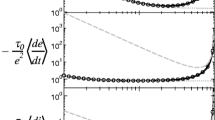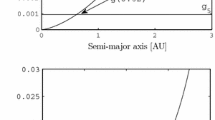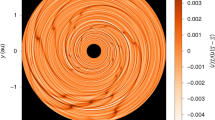Abstract
Massive gaseous nebula has been a key element to formation of large solid objects (planetesimals, giant planet cores) in the early phase of the Solar system evolution. Here, we focus on its effects during the stage when giant planets have already fully formed. Dynamical effects of the nebula on motion of planetesimals stirred by planets were twofold: (i) global gravitational acceleration, and (ii) local aerodynamic drag. Thanks to decreasing gas density with radial distance, in the outer Solar system the effect of the drag was deemed to be important only for small planetesimals (sizes \(\lesssim 10\) km). However, we find that it was possibly important up to the sizes of \(\simeq 100\) km as well. The gravitational field of the nebula produces secular oscillations of the orbital eccentricity and inclination of planetesimals. Eventually, their pericenter may be lifted away from strong planetary influence, exhibited during close encounters, even for small bodies born in the planetary heliocentric zone. It has been previously suggested that such pathway may, in some nebula models, launch planetesimals onto large-inclination and small-eccentricity orbits in the trans-Neptunian region. These orbits would be dynamically stable to present epoch. Our simulations generally do not support such extreme cases, but we find that, after the nebula disperses, some planetesimals may indeed reach low-inclination and low-eccentricity orbits exterior to Neptune. These bodies may have been implanted into the Kuiper belt during subsequent planetesimal-driven migration of planets. This raises a possibility that some present-day KBOs may have formed in the giant-planet zone (5–20 au).
















Similar content being viewed by others
Notes
In addition, orbital structure of planetesimals scattered by Jupiter onto \(a<5\) au orbits is now also very different. The effects of aerodynamics gas drag make them evolve onto low-eccentricity orbits, many embedded in the asteroidal main belt (see, e.g., Raymond and Izidoro 2017).
Note there are more particles left at the end of our simulations, namely those still strongly interacting with planets. However, since the timing of giant planet instability is not exactly known (e.g., Nesvorný et al. 2018), we are not primarily interested in them. For instance, if the reconfiguration occurred at 50 Myr, many of these particles will be still eliminated by effects of close encounters with planets.
References
Alexander, R.D., Clarke, C.J., Pringle, J.E.: Photoevaporation of protoplanetary discs—II. Evolutionary models and observable properties. MNRAS 369, 229–239 (2006). https://doi.org/10.1111/j.1365-2966.2006.10294.x. arXiv:astro-ph/0603254
Batygin, K., Brown, M.E., Betts, H.: Instability-driven dynamical evolution model of a primordially five-planet outer Solar system. Astrophys. J. Lett. 744, L3 (2012). https://doi.org/10.1088/2041-8205/744/1/L3. arXiv:1111.3682
Beaugè, C., Ferraz-Mello, S.: Resonance trapping in the primordial solar nebula: the case of a stokes drag dissipation. Icarus 103(2), 301–318 (1993). https://doi.org/10.1006/icar.1993.1072
Binney, J., Tremaine, S.: Galactic Dynamics, 2nd edn. Princeton University Press, Princeton (2008)
Brasser, R., Duncan, M.J., Levison, H.F.: Embedded star clusters and the formation of the Oort cloud. II. The effect of the primordial solar nebula. Icarus 191, 413–433 (2007). https://doi.org/10.1016/j.icarus.2007.05.003
Byrd, P.F., Friedman, M.D.: Handbook of Elliptic Integrals for Engineers and Physicists. Springer, Berlin (1971)
Earn, D.J.D.: Potential-density basis sets for galactic disks. Astrophys. J. 465, 91–95 (1996). https://doi.org/10.1086/177404. arXiv:astro-ph/9601101
Hayashi, C.: Structure of the solar nebula, growth and decay of magnetic fields and effects of magnetic and turbulent viscosities on the nebula. Prog. Theor. Phys. Suppl. 70, 35–53 (1981). https://doi.org/10.1143/PTPS.70.35
Hayashi, C., Nakazawa, K., Nakagawa, Y.: Formation of the Solar system. In: Black, D.C., Matthews, M.S. (eds.) Protostars and Planets II, pp. 1100–1153. University of Arizona Press, Tucson (1985)
Higuchi, A., Kokubo, E., Kinoshita, H., Mukai, T.: Orbital evolution of planetesimals due to the galactic tide: formation of the comet cloud. Astron. J. 134, 1693–1706 (2007). https://doi.org/10.1086/521815
Kretke, K.A., Levison, H.F., Buie, M.W., Morbidelli, A.: A method to constrain the size of the protosolar nebula. Astron. J. 143, 91 (2012). https://doi.org/10.1088/0004-6256/143/4/91. arXiv:1202.2343
Kuzmin, G.G.: A model of a steady-state Galaxy which allows a velocity ellipsoid with three unequal axes. Astronomicheskii Zhurnal 33, 27 (1956)
Lass, H., Blitzer, L.: The gravitational potential due to uniform disks and rings. Celest. Mech. 30, 225–228 (1983). https://doi.org/10.1007/BF01232189
Lemaitre, A., Dubru, P.: Secular resonances in the primitive solar nebula. Celest. Mech. Dyn. Astron. 52, 57–78 (1991). https://doi.org/10.1007/BF00048587
Levison, H.F., Duncan, M.J., Brasser, R., Kaufmann, D.E.: Capture of the Sun’s Oort cloud from stars in its birth cluster. Science 329, 187–190 (2010). https://doi.org/10.1126/science.1187535
Masset, F., Snellgrove, M.: Reversing type II migration: resonance trapping of a lighter giant protoplanet. MNRAS 320, L55–L59 (2001). https://doi.org/10.1046/j.1365-8711.2001.04159.x. arXiv:astro-ph/0003421
Morbidelli, A.: Modern Celestial Mechanics: Dynamics in the Solar System. Taylor & Francis, London (2002)
Morbidelli, A., Tsiganis, K., Crida, A., Levison, H.F., Gomes, R.: Dynamics of the giant planets of the Solar system in the gaseous protoplanetary disk and their relationship to the current orbital architecture. Astron. J. 134, 1790–1798 (2007). https://doi.org/10.1086/521705. arXiv:0706.1713
Nesvorný, D.: Young Solar system’s fifth giant planet? Astrophys. J. Lett. 742, L22 (2011). https://doi.org/10.1088/2041-8205/742/2/L22. arXiv:1109.2949
Nesvorný, D.: Dynamical evolution of the early Solar system. Annu. Rev. Astron. Astrophys. 56, 137–174 (2018). https://doi.org/10.1146/annurev-astro-081817-052028
Nesvorný, D., Morbidelli, A.: Statistical study of the early solar system’s instability with four, five, and six giant planets. Astron. J. 144, 117 (2012). https://doi.org/10.1088/0004-6256/144/4/117. arXiv:1208.2957
Nesvorný, D., Vokrouhlický, D., Bottke, W.F., Levison, H.F.: Evidence for very early migration of the solar system planets from the Patroclus–Menoetius binary Jupiter Trojan. Nat. Astron. 2, 878–882 (2018). https://doi.org/10.1038/s41550-018-0564-3
Press, W.H., Teukolsky, S.A., Vetterling, W.T., Flannery, B.P.: Numerical Recipes: The Art of Scientific Computing. Cambridge University Press, Cambridge (2007)
Raymond, S.N., Izidoro, A.: Origin of water in the inner Solar system: planetesimals scattered inward during Jupiter and Saturn’s rapid gas accretion. Icarus 297, 134–148 (2017). https://doi.org/10.1016/j.icarus.2017.06.030
Roig, F., Nesvorný, D.: The evolution of asteroids in the jumping-Jupiter migration model. Astron. J. 150(6), 186 (2015). https://doi.org/10.1088/0004-6256/150/6/186
Seccull, T., Fraser, W.C., Puzia, T.H., Brown, M.E., Schönebeck, F.: 2004 EW\(_{95}\): a Phyllosilicate-bearing Carbonaceous Asteroid in the Kuiper Belt. Astrophys. J. Lett. 855, L26 (2018). https://doi.org/10.3847/2041-8213/aab3dc
Vokrouhlický, D., Karas, V.: Stellar dynamics in a galactic centre surrounded by a massive accretion disc—I. Newtonian description. MNRAS 298, 53–66 (1998). https://doi.org/10.1046/j.1365-8711.1998.01564.x. arXiv:astro-ph/9805011
Vokrouhlický, D., Nesvorný, D., Dones, L.: Origin and evolution of long-period comets. Astron. J. 157, 181 (2019). https://doi.org/10.3847/1538-3881/ab13aa. arXiv:1904.00728
Walsh, K.J., Morbidelli, A., Raymond, S.N., O’Brien, D.P., Mandell, A.M.: A low mass for Mars from Jupiter’s early gas-driven migration. Nature 475(7355), 206–209 (2011). https://doi.org/10.1038/nature10201. arXiv:1201.5177
Weidenschilling, S.J.: The distribution of mass in the planetary system and solar nebula. Astropys. Space Sci. 51, 153–158 (1977a). https://doi.org/10.1007/BF00642464
Weidenschilling, S.J.: Aerodynamics of solid bodies in the solar nebula. MNRAS 180, 57–70 (1977b). https://doi.org/10.1093/mnras/180.1.57
Wisdom, J., Holman, M.: Symplectic maps for the n-body problem. Astron. J. 102, 1528–1538 (1991). https://doi.org/10.1086/115978
Acknowledgements
This research was supported by the Czech Science Foundation (Grant 18-06083S). We thank both anonymous referees for interesting comments that helped to improve the final form of the manuscript.
Author information
Authors and Affiliations
Corresponding author
Additional information
Publisher's Note
Springer Nature remains neutral with regard to jurisdictional claims in published maps and institutional affiliations.
This article is part of the topical collection on Trans-Neptunian Objects.
Guest Editors: David Nesvorny and Alessandra Celletti.
Rights and permissions
About this article
Cite this article
Vokrouhlický, D., Nesvorný, D. Effects of protoplanetary nebula on orbital dynamics of planetesimals in the outer Solar system. Celest Mech Dyn Astr 132, 3 (2020). https://doi.org/10.1007/s10569-019-9941-1
Received:
Revised:
Accepted:
Published:
DOI: https://doi.org/10.1007/s10569-019-9941-1




